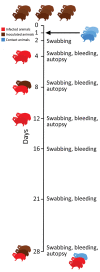Susceptibility of Raccoon Dogs for Experimental SARS-CoV-2 Infection
- PMID: 33089771
- PMCID: PMC7706974
- DOI: 10.3201/eid2612.203733
Susceptibility of Raccoon Dogs for Experimental SARS-CoV-2 Infection
Abstract
Raccoon dogs might have been intermediate hosts for severe acute respiratory syndrome-associated coronavirus in 2002-2004. We demonstrated susceptibility of raccoon dogs to severe acute respiratory syndrome coronavirus 2 infection and transmission to in-contact animals. Infected animals had no signs of illness. Virus replication and tissue lesions occurred in the nasal conchae.
Keywords: 2019 novel coronavirus disease; COVID-19; Nyctereutes procyonoides; SARS-CoV-2; coronavirus; coronavirus disease; raccoon dogs; respiratory infections; severe acute respiratory syndrome coronavirus 2; susceptibility; transmission; viruses; zoonoses.
Figures


Similar articles
-
Experimental Infection of Cattle with SARS-CoV-2.Emerg Infect Dis. 2020 Dec;26(12):2979-2981. doi: 10.3201/eid2612.203799. Epub 2020 Oct 9. Emerg Infect Dis. 2020. PMID: 33034284 Free PMC article.
-
SARS-CoV-2 in Quarantined Domestic Cats from COVID-19 Households or Close Contacts, Hong Kong, China.Emerg Infect Dis. 2020 Dec;26(12):3071-3074. doi: 10.3201/eid2612.202786. Epub 2020 Sep 16. Emerg Infect Dis. 2020. PMID: 32938527 Free PMC article.
-
Lack of Susceptibility to SARS-CoV-2 and MERS-CoV in Poultry.Emerg Infect Dis. 2020 Dec;26(12):3074-3076. doi: 10.3201/eid2612.202989. Emerg Infect Dis. 2020. PMID: 33219803 Free PMC article.
-
Transmission of severe acute respiratory syndrome coronavirus 2 (SARS-CoV-2) to animals: an updated review.J Transl Med. 2020 Sep 21;18(1):358. doi: 10.1186/s12967-020-02534-2. J Transl Med. 2020. PMID: 32957995 Free PMC article. Review.
-
Ocular Symptoms of SARS-CoV-2: Indication of Possible Ocular Transmission or Viral Shedding.Ocul Immunol Inflamm. 2020 Nov 16;28(8):1269-1279. doi: 10.1080/09273948.2020.1799035. Epub 2020 Sep 1. Ocul Immunol Inflamm. 2020. PMID: 32870054 Review.
Cited by
-
Experimental Inoculation of Young Calves with SARS-CoV-2.Viruses. 2021 Mar 9;13(3):441. doi: 10.3390/v13030441. Viruses. 2021. PMID: 33803455 Free PMC article.
-
Experimental SARS-CoV-2 Infection of Bank Voles.Emerg Infect Dis. 2021 Apr;27(4):1193-1195. doi: 10.3201/eid2704.204945. Emerg Infect Dis. 2021. PMID: 33754987 Free PMC article.
-
COVID-19: A pluralistic and integrated approach for efficient management of the pandemic.World J Virol. 2022 Jan 25;11(1):20-39. doi: 10.5501/wjv.v11.i1.20. World J Virol. 2022. PMID: 35117969 Free PMC article. Review.
-
Natural and Experimental SARS-CoV-2 Infection in Domestic and Wild Animals.Viruses. 2021 Oct 4;13(10):1993. doi: 10.3390/v13101993. Viruses. 2021. PMID: 34696423 Free PMC article. Review.
-
Passive Surveillance of SARS-CoV-2 in Adult Blacklegged Ticks (Ixodes scapularis) from Northeast Pennsylvania.Life (Basel). 2023 Sep 2;13(9):1857. doi: 10.3390/life13091857. Life (Basel). 2023. PMID: 37763261 Free PMC article.
References
Publication types
MeSH terms
LinkOut - more resources
Full Text Sources
Medical
Miscellaneous

